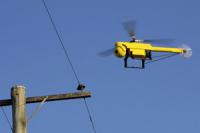-
Novel solution to better secure voice over internet communication
Researchers have developed a novel method to better protect Crypto Phones from eavesdropping and other forms of man-in-the-middle attacks. Crypto Phones consist of smartphone apps, mobile devices, personal computer or web-based Voice over Internet Protocol applications that use end-to-end encryption to ensure that only the user and the person they are communicating with can read what is sent. In order to secure what is being communicated, Crypto Phones require users to perform authentication tasks.
-
-
Improving military communications with digital phased-arrays at millimeter wave
There is increasing interest in making broader use of the millimeter wave frequency band for communications on small mobile platforms where narrow antenna beams from small radiating apertures provide enhanced communication security. Today’s millimeter wave systems, however, are not user friendly and are designed to be platform specific, lacking interoperability and are thus reserved for only the most complex platforms. New program aims to create multi-beam, digital phased-array technology, operating at 18-50 GHz to enhance secure communications between military platforms.
-
-
A custom-fit app for community policing
Apps allowing citizens to report crimes or incidents are now commonplace, but they generally fail to adapt local contexts, cultures and sensibilities. SecureU, a new app that addresses this shortcoming, is currently being tested in five European cities.
-
-
2017 Critical Incident Exercise put first responder technologies to the test
In the wee hours of 29 October 2017, more than 200 people participated in a critical incident exercise and technology assessment, conducted by DHS S&T and partner organizations. The exercise took place at the Grand Central Terminal in New York City, with most of the action occurring on parked trains and on track platforms, and other indoor spaces within the Terminal. Emergency medical technicians were dispatched to quickly convert ramps in front of several track platforms into triage stations. Outside, first responders set up an incident command post and an operations center to coordinate the simulated response.
-
-
Making network-connected systems less vulnerable
The rise of network-connected systems that are becoming embedded seemingly everywhere–from industrial control systems to aircraft avionics–is opening up a host of rich technical capabilities in deployed systems. Even so, as the collective technology project underlying this massive deployment of connectivity unfolds, more consumer, industrial, and military players are turning to inexpensive, commodity off-the-shelf (COTS) devices with general-purpose designs applicable for a range of functionalities and deployment options. While less costly and more flexible, commodity components are inherently less secure than the single-purpose, custom devices they are replacing. DARPA says it trains its sights on the expansive attack surface of commodity off-the-shelf devices.
-
-
$1 billion reward proposed for development of new antibiotics
An international group tasked with researching and developing new economic models to promote antibiotic development is calling for a $1 billion market entry reward for new antibiotics, saying the reward could significantly boost the number of new antibiotics coming to market over the next thirty years. The proposal was made by an international consortium of public health organizations, academic institutions, and pharmaceutical companies supported by the European Medicines Initiative. The $1 billion market entry reward is one of four incentives proposed by the group to stimulate research and development (R&D) for new antibiotics and ensure that critically needed antibiotics are used sustainably and continue to be accessible. “Without incentives, some scientifically promising treatments would probably never make it to patients,” says one expert.
-
-
Synthetic virus tackles antimicrobial resistance
Antibiotic resistance has become an ever-growing global challenge, with more than 700,000 people across the world dying from drug resistant infections every year. As a result, antibiotic discovery has fallen well behind its historical rate, with traditional discovery methods being exhausted. Scientists have engineered a brand new artificial virus that kills bacteria on first contact. This new virus is built using the same geometric principles that determine structures of naturally occurring viruses, known as polyhedral capsids.
-
-
Making production of high explosives cheaper, safer
Scientists from the U.S. Army Research Laboratory (ARL) and the Lawrence Livermore National Laboratory found a solution to a significant challenge in making high-energy explosives. They safely improved the overall chemical yield derived from diaminoglyoxime, known as DAG, and significantly increased the amount of material made per reaction.
-
-
Blast, impact simulations help researchers better understand injuries and body armor

Researchers at Sandia Lab have studied the mechanisms behind traumatic brain injury for about a decade. Their traumatic injury modeling and simulation project began with a head-and-neck representation, and now they’ve created a high-fidelity, digital model of a man from the waist up to study the minute mechanisms behind trauma. The specialized computer modeling and simulation methods help researchers better understand how blasts on a battlefield could lead to traumatic brain injury and injuries to vital organs, like the heart and lungs.
-
-
Drones learn to navigate autonomously by imitating cars, bicycles

Researchers have developed an algorithm called DroNet which allows drones to fly completely by themselves through the streets of a city and in indoor environments. The algorithm had to learn traffic rules and adapt training examples from cyclists and car drivers.
-
-
Using fungi for self-healing concrete to fix bridges
America’s crumbling infrastructure has been a topic of ongoing discussion in political debates and campaign rallies. The problem of aging bridges and increasingly dangerous roads is one that has been well documented and there seems to be a consensus from both democrats and republicans that something must be done. Researchers propose using fungi for self-healing concrete — a low-cost, pollution-free, and sustainable approach to shoring up U.S. infrastructure.
-
-
Thorium reactors could dispose of large amounts of weapons-grade plutonium
Scientists are developing a technology enabling the construction of high-temperature, gas-cool, low-power reactors with thorium fuel. The scientists propose to burn weapons-grade plutonium in these units, converting it into power and thermal energy. Thermal energy generated at thorium reactors may be used in hydrogen industrial production. The technology also makes it possible to desalinate water.
-
-
Checking chemical detectors’ sensitivity to chemicals

The Joint Chemical Agent Detector (JCAD) has become an important defense tool on battlefields and in war-torn cities over the last few years. About the size and shape of a VHS tape or a hardcover bestselling novel, JCADs sound an alarm and begin to light up if nerve agents such as sarin or blister agents such as mustard gas are present. The detectors are already designed to withstand intense environments and repeated use. But when the Department of Defense wanted a way to check the devices’ sensitivity to chemicals over time, a measurement team at the National Institute of Standards and Technology (NIST) was called in to provide a cost-effective solution.
-
-
Interconnected technological risks: Responding to disruptions of cyber-physical systems
When infectious diseases strike, the World Health Organization acts swiftly, coordinating with the U.S. Centers for Disease Control and Prevention and its foreign counterparts to contain the threat. But there is no equivalent international organization similarly dedicated to identifying and mitigating a cyberattack. The World Economic Forum (WEF), however, is bringing together infrastructure and technology developers, insurers and government officials from across the globe to develop strategies for responding to interconnected technological risks, including those that can cascade when hackers disrupt cyber-physical systems.
-
-
Distant-scanning crowds for potential threats
Everyone wants to be safe and secure, but can you imagine if you had to go through a security screening at the metro station like there is at the airport? What if there were a way to safely scan crowds for potential threat items in places like metro and train stations without security officials coming into direct contact with the public and while maintaining individual privacy?
-